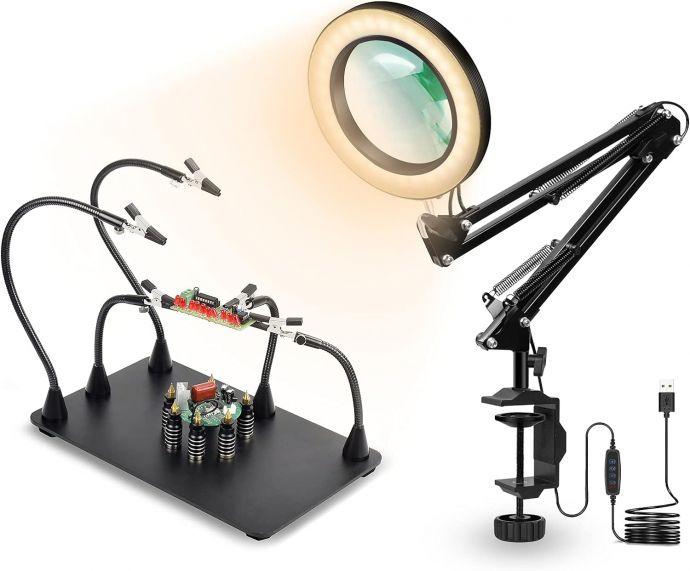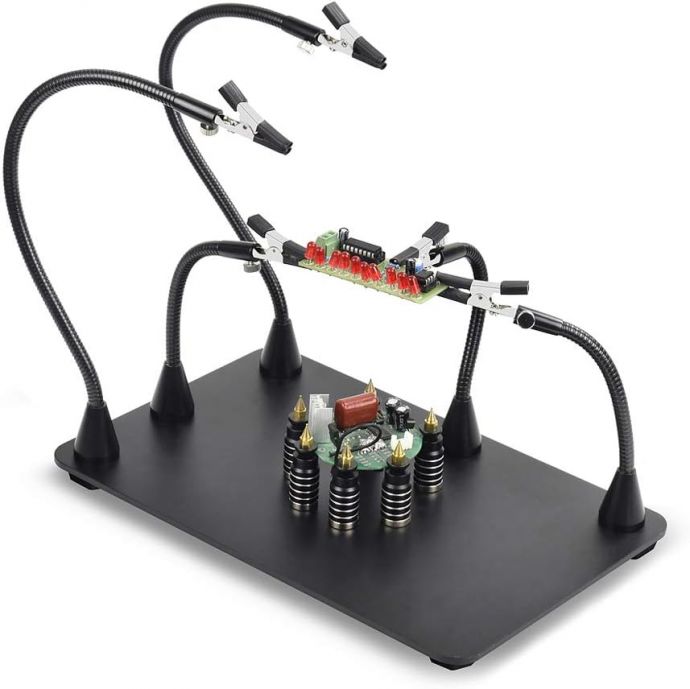In the intricate world of electronics and craftsmanship, soldering forms the backbone of circuit creation and repair. The precision required to deftly connect components via soldering is akin to performing surgery, demanding both accuracy and steadiness. Despite advances in technology, traditional soldering methods have remained mostly unchanged for decades. However, the introduction of advanced tools like specialized camera mounts and clamps marks a significant evolution, transforming soldering practices for hobbyists and professionals alike.
For many enthusiasts, the quintessential tool known as the “helping hands” has been a fixture on their workbenches. Traditionally, this device features a pair of alligator clips attached to adjustable arms, designed to hold components securely in place. While helpful, these basic aids have limitations; they often lack the precision and stability needed for more complex projects involving microelectronics or delicate components. Enter the era of innovation with modern sophisticated camera mounts and clamps, which are redefining standards for accuracy and efficiency in soldering tasks.

At the heart of this evolution is the integration of robust camera mounts designed to provide a clearer and more detailed view of the workpiece. Leveraging high-definition cameras, these mounts allow artisans to magnify their field of view while maintaining a safe distance from potentially harmful fumes emitted during soldering. By pairing these mounts with displays or computer screens, users can navigate minute details with newfound clarity, leading to fewer errors and rework. This visual enhancement transforms the soldering process into an exercise in precision, much like a concert pianist perfecting complex pieces with the aid of sheet music.
The adaptability of modern camera mounts accommodates a variety of angles and positions, offering unparalleled flexibility. Articulating arms and swivel bases enable users to tilt and rotate the camera, ensuring that even the most obstructed components are easily visible. This adaptability is crucial in environments where space is limited, or multi-layered boards require inspection from multiple viewpoints. With these mounts, the tedious task of frequently repositioning the components or oneself is mitigated, significantly improving workflow efficiency.
Complementing these mounts are the sophisticated clamps that have evolved beyond their rudimentary predecessors. Contemporary clamps are crafted with precision engineering akin to instruments in a surgeon’s toolkit. Constructed from durable materials such as stainless steel and anodized aluminum, they are designed to securely hold components without damaging sensitive circuitry or deforming fragile leads. The inclusion of rubberized grips and intricate jaw mechanisms ensures that components are held firmly yet gently, providing stability while minimizing the risk of slip or movement during soldering.

Moreover, the modularity of these clamps plays a crucial role in their functionality. Users can effortlessly swap out or adjust attachments to suit different sizes and shapes of components, optimizing them for each specific task. The ability to finely tune the pressure applied by the clamp arms prevents inadvertent crushing or displacement, allowing for a wide range of applications from assembly of large circuit boards to intricate work with micro-scale parts.
The integration of advanced camera mounts and clamps also brings with it a broader appeal to a more diverse group of practitioners. For educators, these tools are invaluable in a classroom setting, allowing students to observe the intricacies of soldering technique in real-time without crowding the instructor. Such technology provides learners with the opportunity to practice their skills independently, while still having access to comprehensive visual feedback. The act of soldering becomes not just a skill to be acquired, but a lesson in precision craftsmanship and technological prowess.
For professional technicians, these tools have the potential to revolutionize workflow. Enhanced visibility and stability reduce the occurrence of mistakes, thereby improving quality assurance processes and minimizing costly errors. In industries where efficiency and reliability are paramount, such as aerospace or medical device manufacturing, these advancements contribute to shorter production cycles and increased output capability.

The evolution of advanced camera mounts and clamps is emblematic of a larger trend in the world of electronic craftsmanship: the pursuit of precision. With a growing emphasis on miniaturization and complexity of electronic components, the demand for tools that can rise to this challenge is greater than ever. This shift calls for a reevaluation of traditional practices, urging craftsmen to adopt technologies that enhance their capabilities and allow for more intricate work.
In conclusion, the transformation from basic “helping hands” to advanced camera mounts and clamps is not simply an upgrade of tools; it is a leap forward in precision, functionality, and versatility in the soldering process. For those invested in the art of creating and repairing electronic circuits, these innovations provide a pathway to mastering their craft with accuracy and efficiency previously thought unattainable. The future of soldering is bright, powered by tools that keep pace with technological advancement, opening doors for applications and innovations yet to be imagined.





